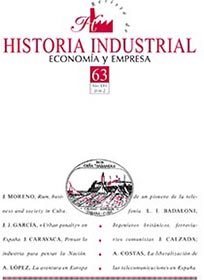Ron, negocios y sociedad en Cuba, 1832-1965
DOI:
https://doi.org/10.1344/rhi.v25i63.21200Palabras clave:
ron, negocios cubanos, capital social, empresarialidadResumen
En este trabajo sostengo la hipótesis de que Cuba pudo convertirse en uno de los grandes países productores de ron a escala mundial gracias a las economías externas generadas por el capital social. En efecto, los roneros cubanos tuvieron que hacer frente a las trabas arancelariasde España, primero, y de Estados Unidos después. Solo gracias a las redes económicas y sociales tejidas por los productores catalanes en los distritos industriales que formaron, las empresas productoras de ron redujeron sus costes y ganaron en competitividad. Por otra parte, tanto las restricciones arancelarias como los elevados costes de transacción internos llevaron a estas a la integración vertical y horizontal. Como resultado de este proceso, Havana Club y Bacardí eran en 1959 dos de las firmas licoreras más poderosas del mundo. Este texto trata de identificar a los fundadores, los orígenes, la organización y la estrategia de las grandes empresas cubanas no azucareras, no del todo bien conocidas por la historiografía.
Descargas
Descargas
Publicado
Cómo citar
Número
Sección
Licencia
El/la autor/a cede los derechos al/la editor/a. Creative Commons
El/la autor/a que publica en esta revista está de acuerdo con los términos siguientes:
- El/la autor/a cede en exclusiva todos los derechos de propiedad intelectual al/la editor/a para todo el mundo y toda la duración de los derechos de propiedad intelectual vigentes aplicables.
- El/la editor/a difundirá los textos con la licencia de reconocimiento de Creative Commons que permite compartir la obra con terceros, siempre que éstos reconozcan su autoría, su publicación inicial en esta revista y las condiciones de la licencia.





